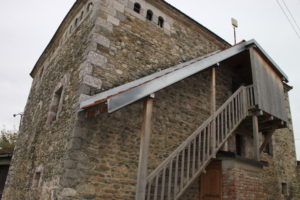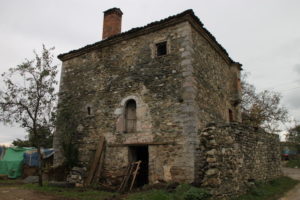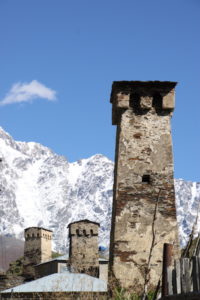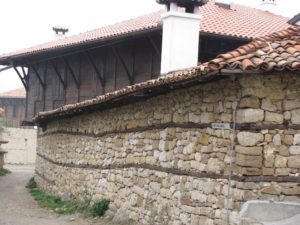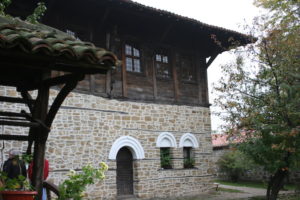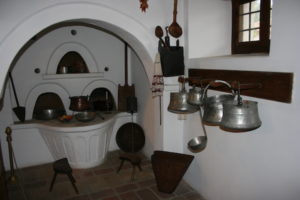I’ve just written a couple of posts about Italy’s medieval tower houses because I found them fascinating — and a kind of unifying theme for some sightseeing while in Italy last year.
However, considering mankind’s penchant for war or for simple thuggery, I guess it’s no wonder I’ve encountered other private housing built with defense in mind. My favorite examples in Europe are:
Kosovo. The traditional kulla, a fortified home of two or three stories on a square base, features thick stone walls and, at ground level, is windowless. Living quarters were on the second floor, but families slept in nearby buildings in peacetime. Kosovars, who are ethnic Albanians, built hundreds of the homes in western Kosovo in the late 18th and early 19th centuries when the area was part of the Ottoman empire.
In the 20th century, Kosovo was part of Yugoslavia and, later, as Yugoslavia began to break up, it remained part of Serbia. In the late 1990s, as Kosovo fought for independence from Serbia, more than 90% of its roughly 500 kullas were severely damaged or destroyed. As symbols of Albanian heritage, the houses had been targeted for destruction.
I don’t know how many have been restored by now, but in 2010, I visited the Drenoc historic zone, which contained numerous kullas in varying states of repair or disrepair.

Above and below, traditional kullas, or fortified family homes, seen in Kosovo’s Drenoc historic zone, an area known for these stone houses.
I shared a group meal with hosts and a visiting delegation of travel professionals at the 200-year-old Mazrekaj Kulla, restored and fitted out for tourism in 2005.
When I visited, the bottom floor, a cowshed, accommodated an impromptu shop. There were sleeping spaces on the second floor; lunch was served on the third floor, a space where, until about 40 years ago, no women were allowed.
Our meal was served at a sofra, a traditional round wooden table, which sits only a few inches off the floor. We sat on cushions on the floor in order to eat a meal of local food: salad, peppers, meat and bread.
The Mazrekaj Kulla is now listed as a B&B at Airbnb.
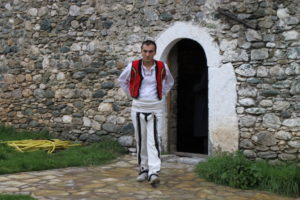
One of our hosts, in traditional Kosovar garb, at the entry to the 200-year-old Mazrekaj Kulla. The home was restored and fitted out for tourism and now appears as a housing option at Airbnb.
Georgia. The approximately 600 tower houses in Upper Svenati in the Caucasus Mountains of northern Georgia (the country) were never meant to be housing. Symbols of each family’s strength, they were built for refuge in emergencies.
They were usually five stories tall, and residents entered at the second level via a hanging ladder used to prevent unwanted incursions. I walked among several at Ushguli, described as Europe’s highest-altitude village — never mind that not everyone considers this Europe or agrees on the altitude, which may be around 7,200 feet.
During the three hours of mountain driving to and from Ushguli (Mestia, a ski resort, was the starting point), I saw scores of stone tower houses in valleys and on hilltops. Mestia has a rich collection as well.

A single tower and a few houses in the small Georgian village of Ipari, all dwarfed by their setting in the Caucasus Mountains. This was typical of the mountain scenes en route to Ushguli.
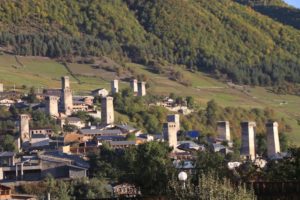
Mestia, the ski resort town in Georgia’s Caucasus Mountains, has its own rich collection of tower houses.
Upper Svenati’s towers generally date from the 16th and 17th centuries, but in Ushguli, some date from the 11th and 12th centuries. At Ushguli’s altitude, the towers make a dramatic scene.
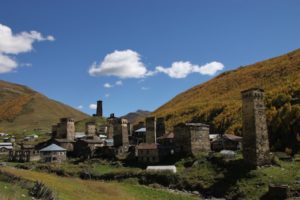
Above and below, views of the house towers on display in Ushguli, set high in the Caucasus Mountains.
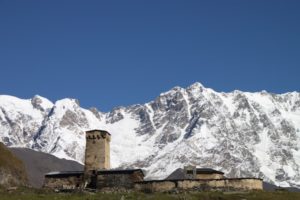
This tower belongs to the Lamaria Church in Ushguli in Georgia’s Upper Svenati region. The village sits among some of the country’s highest mountains.
Bulgaria. Now I’ll talk about houses there weren’t towers but were definitely built as defensive establishments — in Bulgaria at the time the Ottoman Turks were overlords.
In the 16th to 18th centuries, the town of Arbanasi was populated with merchants and artisans who had special privileges under the Turks. But, because of their wealth, they were vulnerable to robbery, which explains residents’ large fortress-like houses.
The homes sat in vast yards surrounded by stone walls up to four meters (12-plus feet) high. The owners’ families lived on the second floor; the ground floor provided storage space and housing for servants. By the 17th century, the town had about 1,000 such houses.
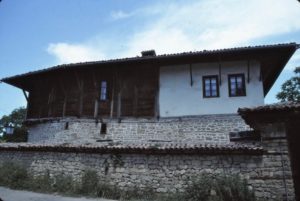
Above and below, typical merchant houses, surrounded by stone walls for safety, seen during my 1995 visit to Arbanasi, Bulgaria.
About 50 of those houses remain, and I visited the upstairs living quarters in two, the Iliev House in 1995 and Konstantsaliev House in 2009. On the inside, they offered all the comforts that wealth could buy, in the style appropriate to their time and place.
The houses still draw tourists to Arbanasi (along with the town’s 16th-17th century Nativity Church, BTW; this is a tiny plain stone building that surprises with a riot of colorful frescoes covering its interior).
Now, I will let photos finish this discussion.

Above and below, interior of the he Konstantsaliev House, seen during my 2009 visit to Arbanasi, Bulgaria.
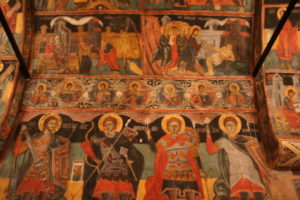
A sample of the frescoes that covered the inside of Arbanasi’s Nativity Church. Its plain-Jane exterior gave no hint of the extensive and prized artwork inside. The church is now a museum but is he setting for occasional religious services.
Meanwhile, for more about Bulgaria, we offer at BestTripChoices.com the following, under the headline, Smell the roses: https://besttripchoices.com/international-countries/bulgaria/
This blog and its photos are by Nadine Godwin, BestTripChoices.com editorial director and contributor to the trade newspaper, Travel Weekly. She also is the author of “Travia: The Ultimate Book of Travel Trivia.”

